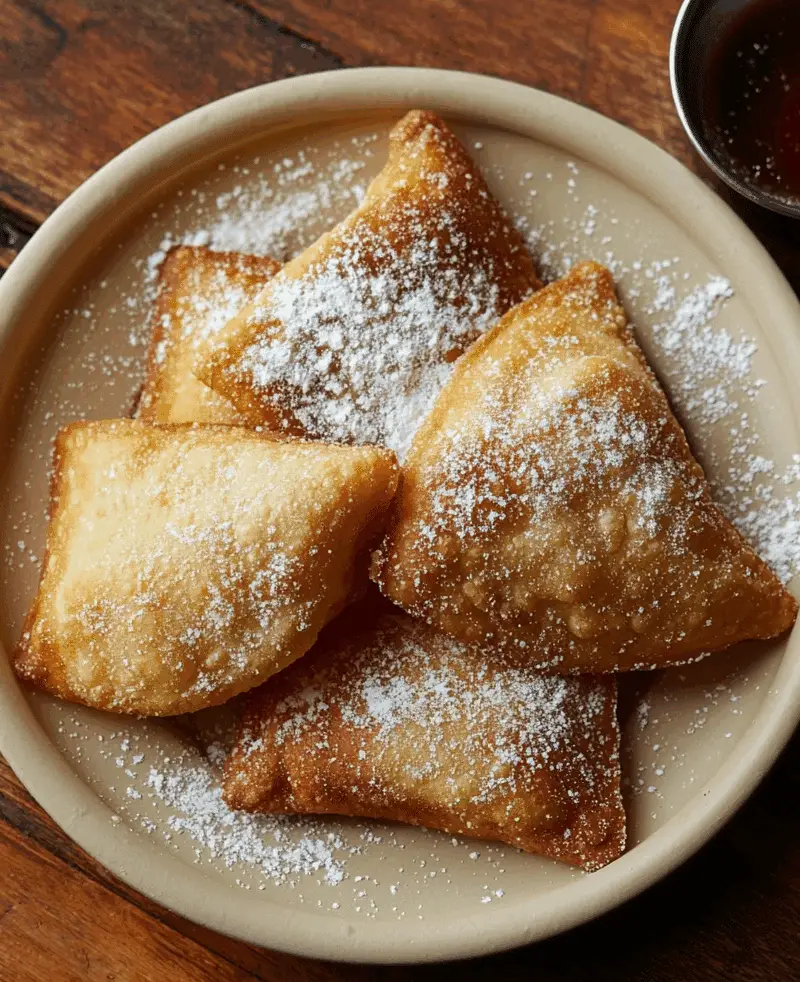These golden Sopaipillas are a beloved treat in traditional Mexican kitchens, especially popular during cooler months or festive gatherings. Lightly puffed, crispy on the outside and soft inside, they are typically served with warm piloncillo syrup or honey for a cozy, sweet finish.
Simple to make and incredibly satisfying, Sopaipillas are perfect for sharing with family and friends. Whether dusted with powdered sugar or drizzled with syrup, they’re a comforting reminder of time-honored recipes passed down through generations. Pair with hot chocolate or café de olla for a truly nostalgic experience.
Full Recipe
Ingredients:
-
2 cups all-purpose flour
-
1 ½ teaspoons baking powder
-
½ teaspoon salt
-
2 tablespoons unsalted butter, softened
-
¾ cup warm water (approx.)
-
Vegetable oil, for frying
-
Piloncillo syrup or honey, for drizzling
-
Powdered sugar (optional), for dusting
Directions:
-
In a large bowl, combine the flour, baking powder, and salt. Mix well.
-
Add the softened butter and incorporate it into the flour mixture using your hands until it resembles coarse crumbs.
-
Gradually add warm water, mixing until a smooth dough forms. Knead the dough for 5–7 minutes until soft and elastic.
-
Cover the dough with a clean towel and let it rest for 30 minutes.
-
Divide the dough into 2 equal parts. Roll each into a thin sheet (about ⅛-inch thick) on a lightly floured surface.
-
Cut into 3 to 4-inch squares or triangles using a sharp knife or pizza cutter.
-
Heat about 1 inch of vegetable oil in a deep skillet over medium-high heat until it reaches 375°F (190°C).
-
Fry the pieces of dough a few at a time, turning once, until puffed and golden brown on both sides (about 1 minute per side).
-
Remove and drain on paper towels.
-
Serve warm, drizzled with piloncillo syrup or honey. Optionally, dust with powdered sugar for extra sweetness.
Prep Time: 15 minutes | Cooking Time: 15 minutes | Total Time: 30 minutes
Kcal: 210 kcal | Servings: 6 servings
Origins of Sopaipillas in Mexican Cuisine
Sopaipillas have deep roots in Latin American culinary traditions, especially within Mexican cuisine. While some variations are found throughout South America and even in New Mexico (USA), Mexican sopaipillas stand out due to their simple ingredients and authentic preparation techniques passed down through generations. In Mexico, they are often considered a comfort food, frequently made during colder months, family gatherings, or religious celebrations.
The name “sopaipilla” is derived from the Mozarabic word xopaipa, meaning bread soaked in oil, which reflects the dish’s core method—frying dough to golden perfection. Although often sweet, in some Mexican regions, savory versions exist and are served with salsa or cheese. The versatility of sopaipillas has allowed them to remain popular in modern kitchens while staying true to their rustic, traditional origins.
Cultural Significance and Traditions
Sopaipillas are more than just a dessert—they are a part of Mexico’s culinary identity. In many rural areas, they are a staple treat made by grandmothers and mothers during festive times such as Christmas, Day of the Dead, and family Sundays. Serving them with piloncillo syrup, a rich, dark syrup made from raw sugar cane, connects the dish with indigenous and colonial history, where sugar cane and other native ingredients shaped much of the cuisine we know today.
Children often help roll out and cut the dough, turning sopaipilla-making into a shared family experience. In some Mexican states, like Puebla and Oaxaca, they might be sold in street markets or at local festivals, adding to their cultural importance and culinary nostalgia. The preparation itself symbolizes simplicity and resourcefulness—key values in traditional Mexican cooking.
Texture, Flavor, and Visual Appeal
The hallmark of a well-made sopaipilla is its puffed, airy center and golden-brown exterior. When dropped into hot oil, the dough expands quickly, forming a pocket of steam that gives the bread its signature puff. This puffiness is not only visually satisfying but also creates a delightful texture contrast—crispy outside and soft, chewy inside.
Flavor-wise, sopaipillas are slightly savory on their own due to the butter and salt in the dough, which pairs wonderfully with sweet toppings. A drizzle of piloncillo syrup infuses them with deep molasses notes and earthy sweetness, while honey or a dusting of powdered sugar brings a more delicate touch. Some cooks infuse the syrup with cinnamon or orange peel for added aroma and depth.
Serving Suggestions and Variations
While traditionally served as a dessert or snack, sopaipillas are incredibly versatile. In northern Mexico, they may accompany a cup of café de olla, spiced Mexican coffee sweetened with piloncillo. In other areas, they’re a mid-afternoon indulgence, sometimes served with hot chocolate or atole.
You can also enjoy them with creative toppings like whipped cream, chocolate drizzle, or even sweetened cream cheese for a fusion twist. On the savory side, try stuffing them with beans and cheese or serving them alongside soups as a bread substitute. For a modern take, some chefs experiment with adding vanilla extract, citrus zest, or anise seeds to the dough, enhancing the aroma without altering the traditional structure.
How Sopaipillas Compare to Other Fried Breads
Fried breads are a staple in many global cuisines, from beignets in New Orleans to Indian puris and Hungarian lángos. However, Mexican sopaipillas maintain a unique identity. Unlike beignets, which are usually heavily sweetened and powdered, sopaipillas can be both sweet or savory. Compared to puris, which are usually thinner and not sweetened, sopaipillas are thicker and designed to be enjoyed as a treat rather than part of a savory meal.
The use of piloncillo syrup specifically differentiates Mexican sopaipillas from New Mexican versions, which often use honey or are dusted with cinnamon sugar. This syrup adds a rich, authentic layer of flavor not commonly found in other types of fried bread.
Nutritional Notes and Dietary Considerations
While sopaipillas are traditionally fried, they can be made healthier by baking them instead, though they may not puff up as dramatically. The dough itself is relatively simple and can easily be made dairy-free or vegan by substituting the butter with plant-based alternatives.
Additionally, the portion size and toppings greatly influence their nutritional profile. A small sopaipilla with a light drizzle of honey or syrup can be a moderate treat, while adding cream or heavy sweeteners can increase the calorie count. The basic recipe is cholesterol-free and low in sugar until the toppings are added, making it adaptable for different dietary preferences.
Tips for Perfect Sopaipillas at Home
Getting the dough texture right is key. It should be smooth, elastic, and not sticky. Resting the dough after kneading allows the gluten to relax, which helps it roll out easily and puff evenly during frying. Always make sure your oil is at the right temperature—around 375°F (190°C). Too low, and the sopaipillas will absorb oil and become greasy; too high, and they’ll brown too quickly without puffing properly.
Using a deep, heavy-bottomed skillet or Dutch oven provides more consistent heat, and frying a few at a time ensures the oil stays hot. Drain them on paper towels right after frying, and serve warm for the best taste and texture.
Piloncillo Syrup: The Traditional Sweetener
Piloncillo is a cone-shaped, unrefined sugar made from sugar cane juice. Its deep, caramel-like flavor is richer and more complex than regular brown sugar or molasses. To make the syrup, piloncillo is melted down with water, cinnamon sticks, and sometimes orange peel or clove. The result is a sticky, aromatic syrup that’s perfect for drizzling over hot sopaipillas.
Many cooks in Mexico keep a jar of homemade piloncillo syrup on hand—not just for sopaipillas, but also for sweetening drinks or other traditional desserts like buñuelos and capirotada.
Why Sopaipillas Are Still Loved Today
Despite the changing trends in modern desserts and snacks, sopaipillas remain timeless. Their appeal lies in their simplicity, flexibility, and the comfort they bring. With only a handful of pantry staples and a bit of technique, anyone can create a plate of golden, puffy bread that tastes like home.
Whether you’re honoring your family traditions or discovering them for the first time, sopaipillas are a delicious and approachable way to celebrate Mexican culinary heritage. Their ability to adapt—whether through fillings, toppings, or dietary tweaks—makes them perfect for any kitchen.
Conclusion
Sopaipillas represent the heart of Mexican comfort food—humble ingredients transformed into something unforgettable. Rooted in tradition but open to modern interpretations, these golden pillows of fried dough carry with them the warmth of family, culture, and celebration. With a crispy shell, soft interior, and rich toppings, they’re a delight for all ages.
Including sopaipillas in your recipe collection connects you with generations of cooks who have lovingly prepared them for their loved ones. Whether enjoyed at a festival, around the family table, or as a weekend treat, sopaipillas are more than food—they are a flavorful reminder of shared history, creativity, and home.








